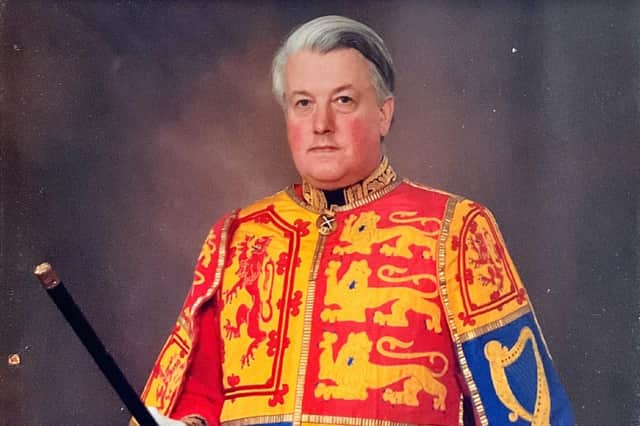Scotsman Obituaries: Alastair Campbell of Airds, soldier and historian


Alastair Campbell of Airds, who died aged 85 on 10 November 2022, was a soldier and Highland historian who promoted the name of Clan Campbell and its Argyllshire homeland around the world.
A giant of a man at 6ft 6in tall who began most days with a full cooked breakfast, tropical disease forced him to forego the military career that ability and family tradition – his father won the Victoria Cross – laid out for him. Instead, he devoted his many talents, energy and affable nature to preserving and promoting a wide range of ancient and not-so-ancient Scottish traditions.
Advertisement
Hide AdAdvertisement
Hide AdAs chief executive of Clan Campbell and archivist to the then Clan Chief Ian, the 12th Duke of Argyll, he spent much of his career, according to his son Johnny, “effectively employed in his favourite hobby”. His magnum opus was his three-volume The History of Clan Campbell (2000), but other books include histories of The Argyll and Sutherland Highlanders, The Royal Company of Archers and The Highland Society of London.
Alastair Campbell was born on 11 July 1937, the son of Brigadier Lorne Campbell VC, DSO and bar, OBE, TD, and Amy Muriel Jordan. He was educated at Eton, where he was an Oppidan Scholar. Inspired by his father’s heroics – his VC at the Battle of Wadi Akarit was the only one awarded to the hard-fighting 51st Division in the entire Second World War – and by his grandfather and other forebears, he joined The Argyll and Sutherland Highlanders in 1957. There he served as a platoon commander under Major Colin Mitchell (later “Mad Mitch” of Aden fame), conducting aggressive operations against the Greek Cypriot nationalist fighters EOKA in the Cyprus Emergency. Mitchell later described him as “not at his best as a subordinate, having left Sandhurst with a field marshal’s baton firmly in his sporran”.
At one stage in the insurgency, he helped foil a terrorist plot by escorting to the local police station two suspicious-looking men claiming to be plumbers. As it turned out, their profuse sweating on the bumpy Land Rover journey was down to their having 18 highly unstable sticks of dynamite in the sack said to contain pipe fittings.
On return to more mundane duties as a training subaltern at the Regimental depot, one platoon training exercise included enlisting his men in an investigation of the unsolved 1752 murder of the pro-Hanoverian Colin Campbell of Glenure (the Red Fox of Stevenson’s Kidnapped), using mine detectors to search for musket balls. The exercise attracted good publicity for The Argylls and, much to his delight, involved him in onerous correspondence with amateur historical sleuths, some on the fringes of sanity.
A posting to post-independence Nigeria, as chief instructor of the infantry wing at the Nigerian Military Training College in Kaduna, helped end his career in the regular army. Although the landscape was beautiful and the lifestyle enjoyable, Sandhurst had not prepared him for the menacing background of corruption, inter-tribal rivalry and juju. Although equal to that, he became ill with jaundice and tick fever. This susceptibility prevented him from joining what would have been his next Argylls’ deployment, to the jungles of Borneo.
Remaining active in the Territorial Army with The Queen’s Royal Rifles and The Royal Green Jackets, he joined the family wine shipping business of Reid, Pye and Campbell in the City, and then Waverly Vintners, the wine and spirits division of Scottish and Newcastle, where he rose to be managing director. But the firm struggled in the more competitive world following late-1970s industry changes, and he was glad in 1983 to take up the archivist role at Inveraray Castle.
As well as being envoy to the global Campbell diaspora, Alastair Campbell’s many public roles included that of the office of Unicorn Pursuivant of Arms in Ordinary at the Court of The Lord Lyon. On retirement, he was made Islay Herald of Arms Extraordinary, a rarely bestowed honour. As a member of the Order of St John, he was Sword Bearer to the Scottish Prior of the Order.
He was a member of The Queen’s Body Guard for Scotland, The Royal Company of Archers; Senior Steward of the Argyllshire Gathering and an honorary reader in history at the University of Aberdeen. He made a creative contribution for many years on The Argylls’ Regimental Museum Committee at Stirling Castle.
Advertisement
Hide AdAdvertisement
Hide AdBehind the scenes, he helped prepare the Register of Scottish Tartans Act (2008) and helped launch the Keepers of the Quaich, the international society that recognises contributions to the Scotch whisky industry.
As Argyll council member of the National Trust for Scotland, he instigated the refurbishment of the Glencoe visitor centre, insisting on a proper historical perspective on the infamous 1692 massacre of Glencoe MacDonalds – by government troops, he stressed, not Campbell clansmen.
Alastair Campbell was also a talented and versatile amateur artist and cartoonist, adept at landscape, military and heraldic painting. In retirement, he was able to continue painting long after being forced to give up other passions including fishing, deerstalking and walking the hills with his beloved spaniels. His 62-year marriage to Mary Ann was exceptionally strong and a stream of guests passed happily through their house at Inverawe over the decades, the antics of their children’s friends meeting more tolerance than they expected.
Alastair Campbell is survived by Mary Ann, whom he married in 1961, and by a daughter, three sons, and seven grandchildren. His 104-year-old mother-in-law Dame Frances Campbell-Preston, a lady-in-waiting to The Queen Mother, outlived him by 11 days.
Obituaries
If you would like to submit an obituary (800-1000 words preferred, with jpeg image), or have a suggestion for a subject, contact [email protected]
Subscribe
Subscribe at www.scotsman.com/subscriptions